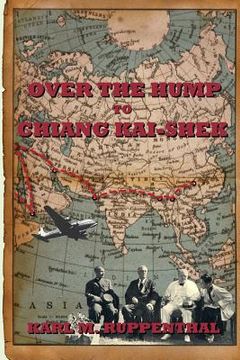Reseña del libro "Over the Hump to Chiang Kai-shek (en Inglés)"
During World War II, the author was a pilot for Trans World Airlines (TWA). In late 1943, he left Washington, D.C. as second officer on a secret flight, having no knowledge of the plane's ultimate destination or purpose. The plane flew south to Brazil, east to Africa, and then made its way through Egypt and the Middle East to India. After crossing the eastern Himalayan mountains above Japanese-occupied northern Burma (the dangerous China-Burma-India route known by pilots as "the Hump"), this mysterious flight reached China. In Chungking (Chongking), the plane took on two distinguished passengers: General and Madame Chiang Kai-shek, the Chinese Nationalist leaders. The plane's pilots and crew transported the Chiangs to the Cairo Conference with Winston Churchill and Franklin D. Roosevelt. In 1943, airplanes had to stop frequently to refuel. There was no food on board; crew members had to bring their own. Cabins were not pressurized and at higher altitudes, supplemental oxygen was required. There were no satellites, GPS devices, or advanced radar and communications systems. When equipment broke in a foreign land, they either had to fix it themselves or work around it, which could be a matter of life and death. Pilots on long journeys often flew by celestial navigation, which basically required sticking a head out the window to take a reading from the stars. Sometimes, they had to look down to gauge their positions as well, watching the tree tops over a forest or the whitecaps on the ocean's surface to estimate how hard the wind was blowing the plane. Or they flew by dead reckoning, as was necessary when this flight passed over "the Hump" in this book. The job was tough enough without the fact that World War II was raging. While Europe and the Pacific were the war's best known points of focus, there were many places around the world that were unsafe to fly. This 1943 flight avoided the North Atlantic and Europe entirely, reaching China by way of Puerto Rico, British Guiana, Brazil, Ascension Island, modern-day Ghana, Sudan, modern-day Yemen, Egypt, Iran, Pakistan, and India. At that time, there were German boats and planes in the North Atlantic and few places to land safely in Europe. In addition, TWA would not fly over the North Atlantic during the wintertime, fearing and not fully understanding the weather there. And the Pacific and East Asia were at least as bad by 1943, having been almost fully overrun by the Japanese. So they took the southern route, which held dangers of its own, the last part of it flying over passes in the eastern Himalayan mountains and above Japanese-occupied territory where snipers and radio hecklers were active. Northern Burma, which the Japanese had overtaken the year before, was the mountainous territory which pilots called "The Hump". The pilots and crew of this flight had to run that gauntlet four times on this trip, two of them with the Chiangs on board, whom the Japanese would have dearly loved to knock out of the sky. This story illuminates a small slice of World War II history that is seldom told and not well known. It stands as a powerful firsthand account of flying an airplane in remote lands at a time when few people traveled. It is a reminder that pilots and crew members in those days were Renaissance men who made great sacrifices, took nothing for granted, and left family members at home who made sacrifices of their own. This book was written by Karl M. Ruppenthal, who passed away in 2013 at the age of 95. He used his notes and recollections from the time to compile this true story of his amazing journey to China and to the Cairo Conference. This manuscript was published after his death, fulfilling his desire to share the story with the world.

